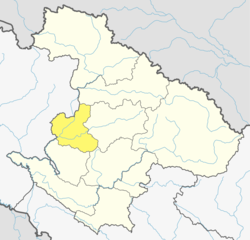Kalikot District
Kalikot District
कालीकोट जिल्ला | |
|---|---|
 Jite Gadhi over the Karnali in Kalikot district | |
| Nickname: त्रिबेणी Tribeņī | |
 Location of Kalikot District (dark yellow) in Karnali | |
| Country | |
| Province | Karnali Province |
| Admin HQ. | Manma (today part of Khandachakra Municipality) |
| Government | |
| • Type | Coordination committee |
| • Body | DCC, Kalikot |
| Area | |
• Total | 1,741 km2 (672 sq mi) |
| Population (2011) | |
• Total | 136,948 |
| • Density | 79/km2 (200/sq mi) |
| Time zone | UTC+05:45 (NPT) |
| Website | ddckalikot |
Kalikot District (Nepali: कालीकोट जिल्ला ⓘ), a part of Karnali province, is one of the seventy-seven districts of Nepal. The district, with Manma as its district headquarters, covers an area of 1,741 km2 (672 sq mi), had a population of 105,580 in 2001 and 136,948 in 2011. In September 2005, in a bid to encourage a change in social attitudes, the government announced that it would provide rice to any family that had recently had a girl born.[1]
Geography and Climate
[edit]| Climate Zone[2] | Elevation Range | % of Area |
|---|---|---|
| Upper Tropical | 300 to 1,000 meters 1,000 to 3,300 ft. |
1.8% |
| Subtropical | 1,000 to 2,000 meters 3,300 to 6,600 ft. |
20.6% |
| Temperate | 2,000 to 3,000 meters 6,400 to 9,800 ft. |
39.4% |
| Subalpine | 3,000 to 4,000 meters 9,800 to 13,100 ft. |
37.3% |
| Alpine | 4,000 to 5,000 meters 13,100 to 16,400 ft. |
0.8% |
Demographics
[edit]| Census year | Pop. | ±% p.a. | ||
|---|---|---|---|---|
| 1981 | 87,638 | — | ||
| 1991 | 88,805 | +0.13% | ||
| 2001 | 105,580 | +1.75% | ||
| 2011 | 136,948 | +2.64% | ||
| 2021 | 144,917 | +0.57% | ||
| ||||
| Source: Citypopulation[3] | ||||
At the time of the 2011 Nepal census, Kalikot District had a population of 136,948.
As their first language, 99.5% spoke Nepali, 0.3% Magar and 0.1% other languages.[4]
Ethnicity/caste: 28.8% were Chhetri, 25.1% Thakuri, 17.7% Kami, 17.1% Hill Brahmin, 5.1% Damai/Dholi, 3.2% Sarki, 1.0% Sanyasi/Dasnami, 0.5% Kumal, 0.5% Lohar, 0.4% Magar, 0.1% Badi, 0.1% other Dalit, 0.1% Teli and 0.2% others.[5]
Religion: 99.8% were Hindu, 0.1% Buddhist and 0.1% Christian.[6]
Literacy: 56.7% could read and write, 4.5% could only read and 38.7% could neither read nor write.[7]
Administration
[edit]The district consists of nine municipalities, out of which four are urban municipalities and five are rural municipalities. These are as follows:[8]
- Khandachakra Municipality
- Raskot Municipality
- Tilagufa Municipality
- Pachaljharana Rural Municipality
- Sanni Triveni Rural Municipality
- Narharinath Rural Municipality
- Shubha Kalika Rural Municipality
- Mahawai Rural Municipality
- Palata Rural Municipality
Former Village Development Committees
[edit]Prior to the restructuring of the district, Kalikot District consisted of the following municipalities and Village development committees:

See also
[edit]References
[edit]- ^ Country Reports on Human Rights Practices - 2005 - US Department of State
- ^ The Map of Potential Vegetation of Nepal - a forestry/agroecological/biodiversity classification system (PDF), Forest & Landscape Development and Environment Series 2-2005 and CFC-TIS Document Series No.110., 2005, ISBN 87-7903-210-9, retrieved Nov 22, 2013
- ^ "NEPAL: Administrative Division". www.citypopulation.de.
- ^ NepalMap Language [1]
- ^ NepalMap Caste [2]
- ^ NepalMap Religion [3]
- ^ NepalMap Literacy [4]
- ^ "स्थानिय तह" (in Nepali). Ministry of Federal Affairs and General Administration. Archived from the original on 31 August 2018. Retrieved 1 September 2018.
External links
[edit]29°9′0″N 81°37′0″E / 29.15000°N 81.61667°E

